Dawn Renee Stephens's Blog, page 11
June 18, 2021
Body Coverings of Animals, How to Help Children Learn About Them in Fantastic and New Ways
Body coverings of animals are a fascinating topic for young children. Moreover, this is an important concept that will help children understand an animal’s ability to survive in its habitat. A creative teaching resource that uses the traditional Mother Goose Rhyme of Mary and Her Little Lamb is a great way to introduce this concept.
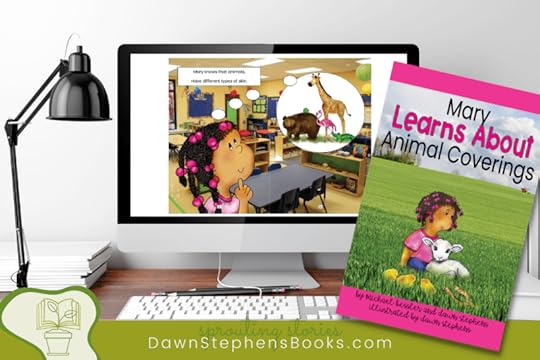 Fur, Fleece, and Wool Coverings of Animals
Fur, Fleece, and Wool Coverings of AnimalsA common covering that children will know is animals that have fur, fleece, or wool. In the traditional rhyme, Mary has a little lamb whose fleece is white as snow. “Fleece” is most likely not a common word for your students. Children are probably more familiar with the terms: “wool” or “fur”. Similarly, they may not understand that these materials are the same as hair. Having different examples of these elements will be very helpful. In addition, providing opportunities to touch and feel actual wool, animal fur, and hair will allow students to compare and contrast this type of animal covering.
 Scales on Animals
Scales on Animals In the lyrics to Mary Learns About Animal Coverings, Mary sees two snakes. The scales on the underside of snakes help them to move along the ground without legs. Scales also protect the animal. Scales can be hard and provide the animal with a hard coat or shield around them. Fish scales make a slime that is slippery and will allow the fish to escape enemies. Scales also protect animals from germs and diseases.
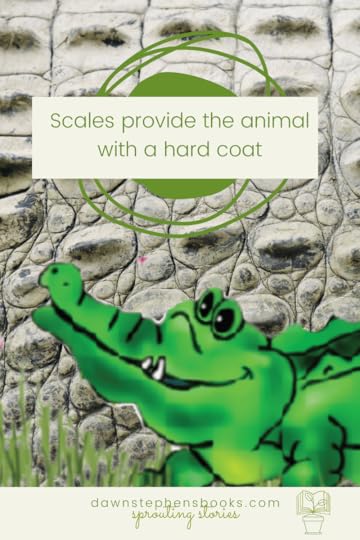 Feathers on Animals
Feathers on AnimalsThe third type of animal covering is feathers. Finally, in the rhyme, Mary sees three birds. Birds have feathers and feathers do a few different things. Feathers keep birds up as they fly through the air.
Some birds do not fly, however. The feathers on these birds can help them to stay warm. Feathers can also keep an animal dry when they swim. Feathers also camouflage some animals and allow them to hide from their predators.

In conclusion, there are great resources to help students to learn about the body coverings of animals. For example, these are available from the Miacademy Learning Channel, and from the resources below.
Disclosure: The links above are affiliate links, meaning, at no additional cost to you, I will earn a commission if you click through and make a purchase.
The post Body Coverings of Animals, How to Help Children Learn About Them in Fantastic and New Ways appeared first on DawnStephensBooks.
June 4, 2021
Lyrics of Little Miss Muffet
The traditional lyrics of Little Miss Muffet are:
Little Miss MuffetSat on a tuffet,
Eating her curds and whey;
Along came a spider,
Who sat down beside her,
And frightened Miss Muffet away.
The poem dates back to the early 19th century in England. Consequently, many people believe that Little Miss Muffet is about a girl named Patience who was Thomas Muffet‘s step-daughter. However, Thomas was a scientist from the 16th century who studied insects and spiders and their effects on medicine.
We will never truly know if Thomas Muffet had anything to do with the lyrics of Little Miss Muffet. Meanwhile, we can still use this rhyme to help young children understand the difference between a spider and an insect. As a result, Michael Kessler and I discovered that kindergarteners could learn to read with nursery rhymes. They could easily recite the rhyme, which made it easier for them to track the text.
Creative teaching resources were hard to find back then. There was not a TpT Store or great teacher blogs to go to. Honestly, I’m talking about a time before we had common and state standards. (Yes, I am that old  ) While the standards were being developed, it was written in the kindergartener’s learning objectives that they know the difference between a spider and an insect. Therefore, Michael and I decided we could change the lyrics of Little Miss Muffet to help our students understand the differences while they were learning to track and read a memorized text.
) While the standards were being developed, it was written in the kindergartener’s learning objectives that they know the difference between a spider and an insect. Therefore, Michael and I decided we could change the lyrics of Little Miss Muffet to help our students understand the differences while they were learning to track and read a memorized text.
Sat on her tuffet
To see if the spider returned.
She studied real hard
By observing her yard,
And wanted to share what she learned.
“You’re not a bug,”
She said with a shrug,
“Compare the two bodies and see.”
“On spiders like you
The parts number two,
but all of the insects have three.” The spider said “Grand. But please understand, Here’s the best way to separate.” “When it comes to feet, We have them all beat.
Bugs have only six; spiders: eight.”
“And look at my eyes;
Is that a surprise?
I hope you will think it first-rate.”
“If you think I’ve two,
Then I have tricked you.
Look closely and you will see eight.”
“I know that,” she said,
“Your body and head
Have eight wiggly legs and eight eyes.”
“And the web that you spin,
Strong, sticky, and thin,
Is useful to catch little flies.”
Many books have told
About spiders, so bold,
Who carry a poisonous bite.
But most will not harm
Your leg or your arm
And usually come out at night.
Once the words were written, we put the text into an illustrated book. As a result, the drawing of the spider and ant did make me squeamish. Likewise, I am not as brave as the Little Miss Muffet in our version. Just thinking about Thomas Muffet using spiders in medicine makes me very glad I did not live at that time too.
Finally, I want to know your story. Is this a topic you enjoy teaching? What creative teaching resources have you found that make this topic fun for all? Leave a comment below.
The post Lyrics of Little Miss Muffet appeared first on DawnStephensBooks.
May 27, 2021
Shadows and Lights’
Shadows and lights’ are the concepts of the latest Mother Goose Meets Mother Nature book. The text takes Jack B. Nimble on a journey where he tries to jump over his own shadow. Similarly, in my quiet time this morning, I realized I am trying to do the same thing.
After I left my career as a principal to pursue creating teacher resources full-time, I have wondered if I knew enough. I have wondered if I am truly doing what God has called me to do or if He will change my path again. In other words, I tend to overthink things and my head sometimes gets in the way of fully trusting God through the next season. You might say I am casting a shadow over the light that God wants to shine.
Shadows cannot be jumped over.Therefore, as I illustrated Jack B. Nimble and the sun, I chuckled as I thought about a little boy who wanted to achieve the feat of jumping his shadow. Then I realized, I am not that much different. I have been wanting to jump over my own shadow too. Like Jack, I want the accolades of success. The shadow that I cast sets a dark spot beside me. It represents something that I cannot clearly see just yet. For instance, I am waiting on a future job or an upcoming business deal. Maybe it is a health report from the doctor. Whatever it is, it is hard to see and I know that I am in the way of God’s light shining on it.
But as Jack learns in the story, shadows move with their source and therefore cannot be jumped. Without light, shadows do not exist. We need the light of Christ in our lives and the shadows we cast are a result of Him being near us. As the light moves around the shadows shift and we eventually see the things that were in the dark.
The shadow means the light is there.Sure, it would be nice to be able to jump over a few of those unseen spots at times. But if we did that, the light would not be as evident to us.
Jack B. Nimble Learns About Shadows is a simple downloadable book that can teach little children about shadows and lights. Similarly, this week taught me something too. As the sun tells Jack, “If the light’s in front or behind, the shadow’s with you all the time”. Just as when God is there (in front or behind me), the shadow I want to skip over is there for a reason.
The post Shadows and Lights’ appeared first on DawnStephensBooks.
March 29, 2021
What Makes a Good Character Education Program?
I have worked in the field of education for over thirty years and know that character is important in both public and private schools. During those years, activities for character education have been developed.
When I first began teaching in the early ’90s, I remember a character education curriculum that used a puppet named Duso the Dolphin. Students were taught to act a certain way and behave because Duso told them to “Do So”. Some parents did not like the idea that we were using a fictional character to motivate students. Some even said that Duso was like a false god. That seemed a little extreme. However, the truth of the matter is that it is hard to teach character education traits without a source for good character. Christians have that source in God. Little Pot’s source is the potter.
A New Idea in Character Education
A new idea in Character Education
Tweet
After writing The Little Pot, I became the principal of an elementary school. The teachers and I thought that the fruit of the Spirit would make the best character education traits. I was hesitant because I did not want our students to think the fruit of the Spirit was something they could be taught in school. It is the qualities of the Holy Spirit and they can only produce that fruit when He lives inside of them. Therefore, I went back to the story of Little Pot and thought through exactly how Little Pot grows fruit. I then took each part of the process and mirrored it with something that was teachable.
The character education activities followed Little Pot’s journey.
Identity within Character EducationLittle Pot first needs to appreciate exactly how the potter shaped it. “The potter made is it just the right size and shape.”
“The potter made is it just the right size and shape.” We can confuse students about their identity. In society’s attempt at giving children choice, children may begin to question the absolutes they need within their life. For example, Gender identity is now defined as something different than that of a child’s sex assigned based on physical characteristics at birth. Even though most children will label themselves as a boy or girl before their third birthday, our society has used the likes and dislikes of play, hairstyle, dress, and such characteristics of children to label them as different genders. In fact, if you do a google search for a gender list, you will find over 72 different types of gender that people can now claim to be. Male and female are only two. I can only imagine how this list could confuse a child.
Why is this important to character education?If society can tell children that they are a specific gender based on their character and not their creator, we have lost the source before we have started. And gender is not the only thing our students need to appreciate about themselves. Their skin color, height, eye color, size, age, etc. are all characteristics our children need to be proud of. They need to know that God made them exactly the way He wants them to be, both physically and emotionally.
Humility within Character Education Little Pot was filled with humus soil.
Little Pot was filled with humus soil.Humus soil is the part of the soil that is best for growing things. It is made from organic matter like manure and dead things. We get the word humility from the word humus. So, just as Little Pot contains humus, we need to contain humility. The things that make humus soil (manure and dead things) can help children to understand humility.
Manure:We often describe the bad things that happen in our lives as manure (or another word that means manure). Does God allow bad things to happen to us? Why? One reason is that it makes us humble. We grow when we experience bad things because we want things to get better. Likewise, we can learn what it feels like and help someone else who is going through it too.
Dead Things:Throughout scripture God asks us to die to ourselves so that we can He can live through us. The connection is that we choose to put God above ourselves. We put others above ourselves too. What things do we want to do that we may need to “put to death” so Jesus can live through us?
God’s Word within Character Education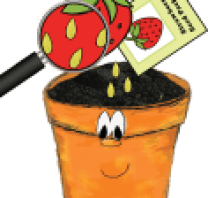 Little Pot needs a seed to be planted.
Little Pot needs a seed to be planted.After the soil, is the seed. If we want to grow good character, we need a seed too. Jesus tells us in the parable of the sower that the seed is God’s Word. Do not underestimate how teaching our students the Bible will result in good character and specifically the qualities in the fruit of the Spirit. Students need to “plant” God’s Word in their hearts. If God’s Word is taking root, the good character will germinate and emerge.
Integrity within Character Education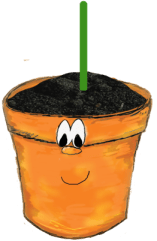 A stem grows. The stem represents our integrity.
A stem grows. The stem represents our integrity. No one ever notices the stem. They never look at a plant and say, “Wow, that’s a nice stem.” They notice the leaves, the flower, and the fruit. Moreover, no one really notices our integrity. They will notice the things our integrity supports. If we are trustworthy and honest. Stems provide support for the plant and hold leaves, flowers, and fruit above the ground. In addition, good integrity provides support for us too. A small crack in the stem can damage the plant. Naturally, a small crack in our integrity will keep us from growing good character. Also, Proverbs tells us that a person of integrity is straight and upright. A strong stem will grow straight and upright too.
Relationships within Character Education Along the stem, Little Pot watches leaves form.
Along the stem, Little Pot watches leaves form.The leaves take light and turn it into food for the plant. A process that is known as photosynthesis. If a child has strong integrity, they will form relationships, and each person they have a relationship with can ‘feed’ them with the light of Christ. Without the leaves, the plant cannot grow and bear fruit. Without strong Godly relationships, we cannot grow and bear the fruit of the Spirit.
If a leaf is no longer green and is wilted, it is not absorbing light and producing food for the plant. It can even pull the nutrients away from the part of the plant that is growing. When this happens to a leaf, it will eventually fall off the plant. In the same way, a friend or person that is not providing us with the light of Jesus may be removed from a part of our life so we can grow more fruit. It is important that we build relationships that will absorb the light of Jesus.
Knowledge within Character Education Finally, Little Pot blooms a flower. We bloom knowledge.What does a flower do?
Finally, Little Pot blooms a flower. We bloom knowledge.What does a flower do? Flowers create nectar that attracts bees, butterflies, and other insects. Our knowledge will attract others. These pollinators are searching for nectar in the flower. As Proverbs 2:2-6 tells us, we should also search for knowledge. Pollen lands on the insects as they come and go. It gets left wherever the insects go. Knowledge lands on us as we study, and we leave some of that knowledge wherever we go. It takes all the parts of the flower to make seeds and reproduce. Consequently, we cannot gain new knowledge on our own. Flowers share their pollen with other flowers. It is important to share our knowledge with others. Pollen propagates the development of the seed, and our knowledge should propagate God’s Word. Flowers pollinate during different seasons and at different rates and times as we each gain new knowledge in different seasons and at different rates and times.
The Fruit of the Spirit within Character Education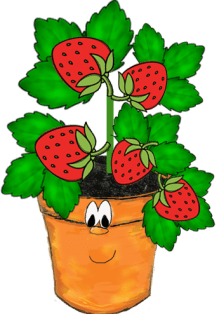 The flower turns to fruit.
The flower turns to fruit.This is the journey that produces fruit. Strawberries withing Little Pot, and the fruit of the Spirit within us. The fruit of the Spirit is love, joy, peace, patience, kindness, goodness, faithfulness, gentleness, and self-control. Good character is made of the same. It cultivates in the right environment and with the right process. Can we educate or teach character? No, but we can fill each other with what is needed, so it will grow. That is what character education should do.
You can purchase this full character education curriculum here.
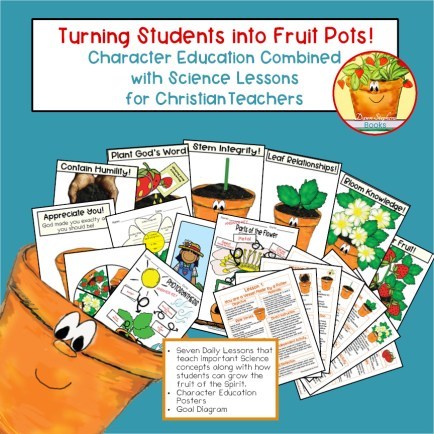 Purchase on TpT
Purchase on TpTThe post What Makes a Good Character Education Program? appeared first on Dawn Stephens.
March 12, 2021
Wait Time in the Classroom … and Life
Teachers are often encouraged to establish wait time in the classroom. Wait time is the seconds or minutes of pause that comes after a question is asked. This period of silence is sometimes challenging for the teacher to not continue talking. With young students, it can be a challenge to keep them focused on the topic. However, the strategy is meant to make the listeners uncomfortable enough that they are forced to answer or participate in the learning. Therefore, I want to explore this concept from the perspective that God, the master teacher, exhibits wait time in the classroom of life.
A year ago, we began to understand what a pandemic would feel like. Consequently, our schools and businesses closed. Life changed and a year later, we never expected to still be waiting for it all to end. The school where I worked closed permanently. I began waiting for a new assignment from God. After that, I became like Little Pot, waiting for something new. I wrote a blog all about it here.
Will you do it now?In the blog, I share how Christ spoke the words, “It Is Finished.” Three days after Christ spoke those words, He rose from the dead. and the followers of Jesus had their faith restored. Once they accepted His resurrection, they quickly became re-focused on Jesus restoring their own desire for Israel. In Acts 1:6 they ask Him. “Will you now restore Israel”? Jesus answers (vs. 7), “It is not for you to know times or seasons that the Father has set”. I resonate with the concept that as soon as they have Jesus back, they begin to ask Him how He is going to accomplish their own immediate needs. His answer, however, is not the answer they (or I) want after a period of waiting.
 “Why do you stand looking at the sky?” Wait time in the classroom may cause your students to stare at the sky.
“Why do you stand looking at the sky?” Wait time in the classroom may cause your students to stare at the sky.Once Jesus answers his students with, “It is not for you to know”, He ascends into the clouds. The followers are left staring into Heaven. Do you wonder how long they stood there? Jesus had already told them their next steps. They would receive power and then be a witness for Jesus in Jerusalem, Judea, and the ends of the earth. But the followers of Jesus were not sure how that would unfold. They had just seen him miraculously ascend into Heaven. So, they stood staring at the clouds. I imagine so many questions were going through their minds. This “Wait-time” went on until two men in white robes appeared and asked them why they continued to stare at the sky. The men explained that Jesus will return. Essentially, they were saying, “What are you waiting for?” Jesus did not tell them to stay there. Jesus told them to Go!
What is wait time for?It is ironic that even though I have the same command in my life, I find myself just standing still. I feel as if I need so much more information before I can begin to move. For instance, I simply do not know what to do next. Some days the possibilities are so many, I do not know which to tackle. Other days the possibilities seem so few, I feel the need to wait until something else comes along. Either way, the truth is I am just like those men and women standing there staring at the sky. The wait time that Jesus puts in our lives is meant to grow us, not immobilize us. We become uncomfortable and are forced to participate in the conversation.
How do we go and wait simultaneously?Jesus told His followers to go. Yet they still were waiting. How do we go and wait simultaneously? The next few verses of Acts 1 explain what we should do as we wait for what was to come.
They returned to Jerusalem to the upper room. They met with Jesus before and after His resurrection here. (vs. 12), I am going back to the places that I have met with Jesus too. I have revisited Bible verses where He spoke to me, studied journal entries where we discussed previous events in my life, and reread favorite books that had a huge impact on my spiritual growth. (See below)Secondly, they devoted themselves to prayer (vs. 14,) I am committing extra time to pray. I am searching scriptures to hear God speak and staying in continual conversation with Him.Thirdly, they continued to trust Jesus to provide (vs. 20-26). The disciples needed a person to replace Judas. They prayerfully asked Jesus to choose as they cast lots. As I look at new opportunities and consider various choices ahead of me, I must also trust that God is revealing the right path for me to take.Wait time is essential.If good teachers know that wait time in the classroom is an essential part of every lesson, how much more essential is it for God in growing our relationship with Him? Is there something you are waiting on God for? I wonder if we have considered that the wait time is intentional on His part and serves a better purpose than whatever it is we are waiting for?
Disclosure: The book links above are affiliate links, meaning, at no additional cost to you, I will earn a commission if you click through and make a purchase.
The post Wait Time in the Classroom … and Life appeared first on DawnStephensBooks.
Wait Time
Teachers are often encouraged to establish a little strategy known as “Wait time” into their lessons. Wait time is the seconds or minutes of pause that comes after a question is asked. This period of silence is sometimes challenging for the teacher to not continue talking. With young students it can be a challenge to keep them focused on the topic. The strategy is meant to make the listeners uncomfortable enough that they are forced to answer or participate in the learning. Today I want to explore this concept from a perspective that God, the master teacher, exhibits “wait time” into our lives.
A year ago, we began to understand what a pandemic would feel like. Our schools and businesses closed. Life changed and a year later, we never expected to still be waiting for it all to end. The school where I worked closed permanently and I began waiting for a new assignment from God. I have been just like little pot waiting for something new.
I wrote a blog all about it here.
In the blog I share how Christ spoke the words, “It Is Finished.” Three days after Christ spoke those words, He rose from the dead. and the followers of Jesus had their faith restored. Once they accepted His resurrection, they quickly became re-focused on Jesus restoring their own desire for Israel. In Acts 1:6 they ask Him. Will you now restore Israel? Jesus answers (vs. 7) it is not for you to know times or seasons that the Father has set. I resonate with the concept that as soon as they have Jesus back, they begin to ask Him how He is going to accomplish their own immediate needs. His answer, however, is not the answer they (or I) want after a period of waiting.
Once he tells them, “It is not for you to know”, He ascends into the clouds. The followers are left standing there, gazing into Heaven. Do you ever wonder how long they stood there? They had already been given the instruction and the next steps. They were going to receive power and then be a witness for Jesus in Jerusalem, Judea, and the ends of the earth. But the followers of Jesus were not at all sure how that would all unfold. They had just seen him miraculously ascend into Heaven. So, they stood there starring at the clouds. I think they were waiting for something more to happen. Anything. What should they do next? I imagine so many questions were going through their minds. This “Wait-time” went on until two men in white robes appeared and asked them why they continued to star at the sky. The men explained that Jesus will return. Essentially, they were saying, “What are you waiting for?” This was not the place that Jesus told them to stay. Jesus told them to Go!
I think it ironic that even though I have the same command on my life, I find myself just standing still. I feel as if I need so much more information before I can begin to move. I simply do not know what to do next. Some days the possibilities are so many, I do not know which to tackle. Other days the possibilities seem so few, I feel the need to wait until something else comes along. Either way, the truth is I am just as those men and women standing there starring at the sky. The wait time that Jesus puts in our lives is meant to grow us, not immobilize us. It is the time that we will become uncomfortable and be forced to participate in the conversation.
The followers of Jesus were told to go. Yet they still were waiting. How do we go and wait simultaneously? The next few verses of Acts 1 explain what we should do as we wait for what was to come.
They returned to Jerusalem to the upper room. This was the place they met with Jesus before and after His resurrection (vs. 12), I am going back to the places that I have met with Jesus too. I have revisited Bible verses where He spoke to me, studied journal entries where we discussed previous events in my life, and reread favorite books that had a huge impact on my spiritual growth. (See below)They devoted themselves to prayer (vs. 14,) I am committing extra time to pray. I am searching scriptures to hear God speak and staying in continual conversation with Him.They continued to trust Jesus to provide (vs. 20-26). The disciples needed a person to replace Judas. They prayerfully asked Jesus to choose as they cast lots. As I look at new opportunities and consider various choices ahead of me, I must also trust that God is revealing the right path for me to take.If good teachers know that “wait-time” is an essential part of every lesson, how much more essential is it for God in growing our relationship with Him? Is there something you are waiting on God for? We are all anxious for this season of a pandemic to end. We are tired of the waiting. I wonder, though, if we have considered that the wait time is intentional on His part and serves a better purpose than whatever it is we are waiting for?
Disclosure: The book links above are affiliate links, meaning, at no additional cost to you, I will earn a commission if you click through and make a purchase.
March 5, 2021
And to think that I saw it … racism or imagination?
And to think that I saw it … Or, to think that I did not. Marco and was not the only one and Mulberry Street was not the only place.
Recently there has been a lot of discussion after Dr. Seuss Enterprises retired six books based on racist imagery. Of the six books, one caught my attention. The book, “And to Think That I saw it on Mulberry Street”, was one of my favorite books as a child. I was curious what racist imagery existed in the book and went online to find out. At the very end of the book, Marco describes a man as “Chinese” and the illustration of this man has two lines for his eyes.
And, to think, that I never saw the racist imagery makes me sad.
That is not surprising. As a child, racism was nothing that I ever thought about in my secluded, all-white world. It was not until I was an adult and a part of the educational system that I began to learn how to see the world from the perspectives of others. If you have not yet read, “White Fragility”, I recommend it. It is a book that can help you understand my upbringing in comparison to someone growing up in a more diverse setting.
Regardless of your opinions on the matter, I am glad our world is paying close attention to the imagery presented to children. I could share about other imagery that I think is dangerous, but that is a blog for another day.
Today, since this book is no longer in print, I wanted to reflect on why this specific story was one of my favorites. Aside from the inappropriate reference, the rest of the book inspired me to use my imagination. Growing up in a Christian home, I knew the difference between telling the truth and telling lies. My parents made sure of that.
The book, “And to Think That I saw it on Mulberry Street” helped me to understand the difference between fictional tales and being honest. In the story, Marco is imagining the wonderful story he could tell his dad about what he saw on the way home from school. He turns a simple horse and wagon into an outlandish tale of elephants, zebras, chariots, and even confetti. Before Marco finishes his thoughts, he has created a parade complete with police escorts and airplanes. In the end, as he rushes inside to share the story, he realizes that his dad is wanting a truthful answer. He leaves the big tale inside his head and shares the simple boring truth with his dad.
And to think that I saw myself in the text.
I identified with Marco so much. I wanted the simple mundane things in my life to be bigger and more exciting too. It was through this book, that I realized children’s stories could be a place where it was possible to create that world. This book was a big part of why I wanted to become a Children’s author and illustrator. As a teacher, it is a book that helped me to see the importance of allowing my students to use their imagination.
How would you finish the sentence, “And to think that I saw …..” ? What books inspired you as a child? Leave a comment below..
Disclosure: The book links above are affiliate links, meaning, at no additional cost to you, I will earn a commission if you click through and make a purchase.
February 23, 2021
Emptied Again.
In John 19:30, Jesus announced, “It is finished”.
On June 5, 2020, as I read John 19:30, the verse resonated with my emotions. That day was my last day as the principal of a school where I had worked for ten years. The school had existed for 51 years and was closing its door permanently. Obviously, me verbalizing that this school and my job being finished was nothing as significant as when Jesus said it as the payment for our sins on the cross. In the Bible, the Greek word translated “it is finished” is tetelestai, an accounting term meaning paid in full. When Jesus said it, He was paying the debt of our sins. His work on earth was complete. He did what He came to do, and that work was the greatest gift ever. So please forgive me for using such a significant event as a connection to finishing my career as the principal of Central Christian Academy. I am going to be bold enough to connect the events only because I believe God was letting me know that He understood what I was feeling that morning.
I have been wanting to write this blog for several months. Many people have asked me to share my thoughts about the closing of a school that I had given everything to for the past ten years. But, honestly, I struggled to put into words my feelings about it all. It was the last week of January before COVID-19 was ever a thing that the decision was made. It was a decision that did not surprise me. What many people do not know is that ten years ago, the school struggled much the same way it had during the past three years. Ten years ago, I was involved in discussions about closing the school. It was through those discussions that I was asked to take the role of principal for just two to three years until we could secure someone else. As I considered the opportunity and what God wanted from me, I knew that two to three years was not enough time. I had run my own business and been involved in enough start-up divisions of larger corporations to know that I would need more than a few years to achieve whatever God wanted from me in this. Back in 2010, I committed ten years to the project. The first five would be used to rebuild the school and the next five would be to see if it could sustain itself. From a business standpoint, the first six to seven years were a great success. The school doubled its enrollment and earned the highest marks from accrediting institutions. From a ministry standpoint, it continually provided opportunities where I was able to impact people with the love of Jesus. Through our new curriculum model and methods, we saw children, parents, and teachers grow spiritually each year. During the past three to four years as the school’s financial needs grew, it was the ministry aspect that kept me fighting to keep the school open. Only God knows the many sleepless nights and the tears that I shed. My inability to give up and let go of the assignment and task He had given me was daunting.
Honestly, COVID-19 forced me to get perspective and face it all. During the weeks at home and helping the teachers run their classes on-line, I got a clearer mindset as to what God needed from me. As I thought about Jesus ending his ministry on earth, I thought about the many people that He never met, or taught, or healed, or was able to have a human-to-human relationship with. There was so much more “Good” He could have done before He went to the cross. However, it was not what His heavenly father wanted him to do. He submitted to His Father’s will and went to the cross. He set aside His own immediate needs and the immediate needs of the people around Him. A much bigger plan was in place.
So, as I removed years of work from computer files, loaded a dumpster with classroom creations, and said goodbye to teachers and students, I tried to stay focused on a bigger plan. A plan that I still do not know or fully understand. But a plan that I am completely submitted to because I know its author is a potter that empties, fills, prunes, waters, and cares for His vessels. As Little Pot is emptied again and again in the story, it realizes that the potter knows what is best. Only through the emptying and pruning can the vessels make room for new growth. Like Little Pot, I seem to have things in my life dumped out often. Maybe it is because I hold on too tightly or value them too much. But I know that it is only when we are emptied that we make room for God to give us new things. The past ten years there was a lot to fill me with. Anyone who has done the job of a principal knows the exhausting responsibilities that go with the job. Of all the things I cherish the relationships the most. It was working with amazing educators, doing ministry with gifted pastors, and being real with parents as we partnered together to help students grow spiritually, socially, and academically that I value the most. That was fruit-bearing. And as the story of Tea Pot illustrates, fruit cannot be taken away. It is used and able to be reproduced again and again. It is never finished.
February 15, 2021
More About Me: Becoming a Fruit Pot
As a child, I never enjoyed school or the conventional and uncreative curriculum my teachers frequently used. I would try to be creative and spent a lot of time drawing pictures all over my school work. Consequently, I felt teachers were mean. I decided at a very young age, that I would NEVER become a teacher. As I grew up and set out to find a career, I met a college student who was able to draw pictures and be creative within her course work. I decided I wanted to major in whatever she was doing. Ironically, she was an elementary education major. After four years of college, I discovered curriculum did not have to be dictated and traditional. Students learn best when teachers use techniques that best serve the learning needs of their students, because many different learning needs exist in one classroom.After college, I began to look for a teaching job where teachers were given the freedom to teach each of their students in different ways. I was faced with two options: a private Christian school or a larger public school system. At that time, the choice was clear. The Christian school strictly followed assigned textbooks and did not allow teachers or students to deviate from a strict syllabus. The public school system worked to address the needs of a very diverse group of students. I said I would NEVER work in a Christian School.At that time, the challenge for public schools was to know if all students, regardless of the teaching techniques, family backgrounds, and socio-economic status, were given the same expectations. As a public school teacher, I joined forces with other educators across the state to develop these standards. Little did we know these standards would one day become a constrained curriculum of their own that would stifle the creativity of both teachers and students.I loved being a teacher. As the years passed, some of my colleagues suggested that I go into school administration. I said I would NEVER become a school principal and planned to be a classroom teacher forever. God, however, had a different plan. After I had three children of my own, I knew He needed me to spend more time taking care of them and less time being a teacher. I reluctantly left the classroom to stay home and care for my own children. While at home, I continued to write creative and non-traditional curriculum for schools. I began to run my own business where I was able to develop these materials and sell them to schools. I discovered that I was pretty successful at running a business, except for one important aspect: sales. Since I was a terrible salesperson, I did not make much money and eventually needed to go find a new job. I knew I would NEVER be a salesperson.I began to talk with a publishing company who wanted to hire me. I was very excited, thinking I would be able to continue to write books and curriculum for them. When they offered me a job, it wasn’t to write or develop curriculum; it was to sell their books. I guess they didn’t know that I was not very good at sales. I accepted the position and was asked to sell Christian books to Christian schools. To make sure schools would buy the books, I did the only thing I knew and continued to write activities and develop fun ways their books could be used in classrooms. With the materials I was creating, schools were buying more and more of their books and I became an instant success as a salesperson.I shared my activities with other sales reps and quickly moved up the corporate ladder to regional manager, and eventually to national sales director. Best of all, Christian schools across the country were now breaking out of their traditional textbooks and teaching creatively through literature.Due to structural changes within that publishing company, the program did not last and I was once again removed from a job that I loved.I was left feeling very upset with God. What was the point of continually trying to serve Him if each time I became successful, He stopped using me? It was through these experiences that The Little Pot story originated.In the story, the potter creates a vessel and explains that he has a special plan for it. The little pot is excited to see what it will become. The potter fills it with papers and the little pot believes its purpose is to be well educated. It feels smart and thinks paper pots are the best pots to be. The potter removes the papers and creates another vessel to hold his important papers. Little Pot is empty and unfulfilled. Next, the potter fills Little Pot with coins. Little Pot feels rich and believes its purpose is to be wealthy. The potter makes another vessel and removes the coins. Little Pot is empty and unfulfilled once again. Finally the potter gives the little pot dirt. Little Pot does not want to be a dirt pot. After the Potter plants something inside the dirt, Little Pot realizes it can grow beautiful flowers. It then believes its purpose is to be beautiful. Shortly after the flowers bloom, however; the blossoms turn hard and green. No longer smart, rich, or beautiful, Little Pot worries once again that it has failed the potter. The potter explains that the hard, green objects are turning into bright, red berries and that Little Pot’s true purpose is to bear fruit.It took me many years and many jobs to learn that God created me simply to be a vessel in which He could grow His fruit. His fruit is love, joy, peace, patience, kindness, goodness, faithfulness, gentleness, and self-control. I was so focused on the things God allowed me to hold in life that I allowed them to define who I was. I had been a teacher, a mom, a business owner, and a sales director. Had I spent those years cultivating the fruit of the Spirit?Once the story was published into a picture book, I became an award winning author and my nature began to, once again, value the accolades and position I held more than what God was able to grow through me. It was then that I was asked to be the administrator of a local Christian school. I had a choice to make. Would I hold onto the success God had given me, or willingly empty myself this time so God could use me to grow the fruit of the Spirit? I accepted the position and figured I had probably better stop announcing the things in life that I would NEVER do.As I moved into the school, I still carried the educational philosophy that students learn best when teachers use techniques that best serve the learning needs of their students. The traditional Christian school curriculum wouldn’t allow us to do that. We began to develop our own. Our purpose was for every child at the school to not only be well educated like the paper pot, financially stable like the coin pot, or beautiful like the flower pot, but vessels that allowed the potter to grow the fruit of the spirit through them as fruit pots. To accomplish this purpose we needed to create an environment that fostered love, joy, peace, patience, kindness, goodness, faithfulness, gentleness, and self-control. We used Little Pot’s process to help us understand what it takes for fruit to grow from us.The process is as follows:
First, we have physical growth.

Little Pot is a uniquely shaped vessel made by the potter. We are different shapes, sizes, and colors made by the potter: God. (Isaiah 64:8) We have various talents, gifts, and abilities. God has designed each of us and expects us to care for ourselves so our bodies can be a vessel useful to Him. Therefore, we must monitor our physical growth.
Then, we need spiritual growth.

The word humility comes from the Latin word humus, which means “good soil.” Little Pot must contain fertile dirt and we must be humble if we are to produce the fruit of the Spirit found in the Bible. (Galatians 5:22-23)
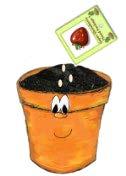
In the Mark 4 and Luke 8 parable, Jesus defines the seed as God’s Word. For Little Pot to grow fruit, it starts with a seed. For us, it begins with planting the Word of God in our lives. The Bible is the source of truth and a part of everything we learn.
Next, comes social growth.

From the seed a stem forms in Little Pot. A stem is straight and upright. In Proverbs 10 and aa the potter tells us that those who walk upright and straight have integrity. We must be people with integrity. No one looks at a plant and says, “Wow! That is a nice looking stem,” just as no one really notices our integrity. However, if a small crack is made in the stem, it will be unable to continue to grow fruit. We only need a small crack in our integrity to stop the fruit of the Spirit from growing through us.

A life of integrity will foster strong relationships. Little Pot needs leaves for photosynthesis (how a plant uses light). Central allows us to grow strong relationships that bring the light of Christ into our lives. A plant can have any number of leaves, just as we can have a lot of friends. Bad leaves need to be removed so they don’t drain the plant of its nutrients and our bad relationships sometimes need to end so we can foster new growth in Christ.
Last, we are able to have academic growth.

With hearty leaves growing, Little Pot blooms flowers. Flowers bloom in different seasons, just as each child learns at a different pace. Through 21st century learning techniques, advanced technology, and individualized instruction, children continually bloom new knowledge
As a result, we bear fruit.
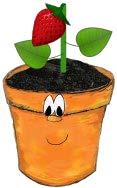
The flower turns to fruit. With physical, spiritual, social, and academic growth, the Potter is able to grow the fruit of the Spirit through us. At Central, each classroom is a fruit stand where love, joy, peace, patience, kindness, goodness, faithfulness, gentleness, and self-control prosper.
After ten years of working in this school and growing the fruit of the Spirit with teachers, students, and their families, God replanted me in Raleigh, North Carolina where I continue to write, illustrate, create resources, and most importantly … grow fruit!
August 26, 2016
Sweet Tea and Children
Last night at our Parent Orientation, Pastor Tim shared these words of wisdom with our families.

by Rev. Tim Robertson
Teaching children how to live and choose wisely is time consuming and difficult.
We carry cell phones … cell phones have so much potential for good. They also remind us the world around us is full of fear, rejection, hate and uncertainty.
Those experiences and emotions aren’t what we want for our children. Parents work hard to protect their children from those negative influences. Parents work tirelessly to provide the safest environment and carefully select the best adults to train and coach their children.
This isn’t easy … life is hard … and more often than not families are struggling with this world where our children are growing up and experiencing life.
Where do you go to find answers? Where can you bring your children to find unrelenting hope, unconditional acceptance and uncompromising coaching?
The church is your answer.
This is the place adults show up week after week committed to show God’s unconditional love and acceptance to your child.
The church is the place children can learn how to make wise choices and choose friends wisely.
The church is the place where we can laugh and be silly and experience a glimpse of what heaven will be like.
The church is the place where what matters most is where you are going not where you have been and to discover how God is shaping you; not to experience how the world is squeezing you.
You see; there is no other place on this earth like the church. It’s the place your children will love to attend if you give them a reason to come.
For our families that have chosen Central Christian Academy, thank you for allowing us to partner with you regarding your child’s education. The school your child attends is very important and here at CCA our educators have been working tirelessly preparing for you. But, CCA or the school of your choice is only part of the total experience you child needs. It’s the home, the church, and the school.
I love sweet ice tea and it takes three items to have a great glass of tea; water, tea and sugar. When one is missing it doesn’t work.
Home … Church … School … if one is missing; don’t fool yourself, it doesn’t work.



